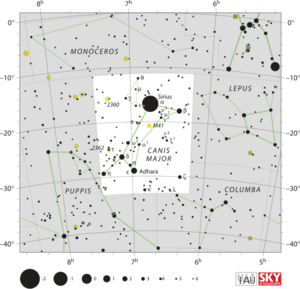Astronomy:Kappa Canis Majoris
| Observation data Equinox J2000.0]] (ICRS) | |
|---|---|
| Constellation | Canis Major |
| Right ascension | 06h 49m 50.45933s[1] |
| Declination | −32° 30′ 30.5225″[1] |
| Apparent magnitude (V) | +3.87[2] |
| Characteristics | |
| Spectral type | B1.5 Ve[3] |
| U−B color index | −0.97[2] |
| B−V color index | −0.20[2] |
| Variable type | γ Cas[3] |
| Astrometry | |
| Radial velocity (Rv) | +14.0±4.1[4] km/s |
| Proper motion (μ) | RA: −8.84[1] mas/yr Dec.: +3.73[1] mas/yr |
| Parallax (π) | 4.95 ± 0.12[1] mas |
| Distance | 660 ± 20 ly (202 ± 5 pc) |
| Absolute magnitude (MV) | −3.03[5] |
| Details | |
| Mass | 12.2±0.3[6] M☉ |
| Radius | 5.9[7] R☉ |
| Luminosity (bolometric) | 18,876[8] L☉ |
| Surface gravity (log g) | 4.07[7] cgs |
| Temperature | 24,600[7] K |
| Age | 13.3±1.2[6] Myr |
| Other designations | |
| Database references | |
| SIMBAD | data |
Kappa Canis Majoris, Latinized from κ Canis Majoris, is a solitary,[10] blue-white hued star in the constellation Canis Major. It is visible to the naked eye with an apparent visual magnitude of +3.87.[2] Based upon an annual parallax shift of 7.70 mas as seen from Earth,[1] this star is located about 660 light years from the Sun.

This is a B-type main-sequence star with a stellar classification of B1.5 Ve,[3] although Hiltner et al. (1969) classified it as B1.5 IVe[13] suggesting it is a subgiant star. The 'e' suffix indicates it is a rapidly rotating Be star with a circumstellar decretion disk of heated gas.[7] The radius of the emitting disk is about 0.20±0.06 astronomical unit|AU, or about 3.7 times the radius of the star.[14] It is classified as a Gamma Cassiopeiae type variable star and its brightness varies from magnitude +3.4 to +3.97.[3] The star became 50% brighter between 1963 and 1978, increasing from magnitude 3.96 or so to 3.52.[15]
Naming
In Chinese, 弧矢 (Hú Shǐ), meaning Bow and Arrow,[16] refers to an asterism consisting of κ Canis Majoris, δ Canis Majoris, η Canis Majoris, HD 63032, HD 65456, ο Puppis, k Puppis, ε Canis Majoris and π Puppis. Consequently, κ Canis Majoris itself is known as 弧矢八 (Hú Shǐ bā, English: the Eighth Star of Bow and Arrow.)[17]
References
- ↑ 1.0 1.1 1.2 1.3 1.4 1.5 van Leeuwen, F. (2007), "Validation of the new Hipparcos reduction", Astronomy and Astrophysics 474 (2): 653–664, doi:10.1051/0004-6361:20078357, Bibcode: 2007A&A...474..653V.
- ↑ 2.0 2.1 2.2 2.3 Feinstein, A.; Marraco, H. G. (November 1979), "The photometric behavior of Be Stars", Astronomical Journal 84: 1713–1725, doi:10.1086/112600, Bibcode: 1979AJ.....84.1713F.
- ↑ 3.0 3.1 3.2 3.3 Watson, Christopher (January 4, 2010), "Kappa Canis Majoris", AAVSO Website (American Association of Variable Star Observers), http://www.aavso.org/vsx/index.php?view=detail.top&oid=5508, retrieved 2014-02-24.
- ↑ de Bruijne, J. H. J.; Eilers, A.-C. (October 2012), "Radial velocities for the HIPPARCOS-Gaia Hundred-Thousand-Proper-Motion project", Astronomy & Astrophysics 546: 14, doi:10.1051/0004-6361/201219219, A61, Bibcode: 2012A&A...546A..61D.
- ↑ Anderson, E.; Francis, Ch. (2012), "XHIP: An extended hipparcos compilation", Astronomy Letters 38 (5): 331, doi:10.1134/S1063773712050015, Bibcode: 2012AstL...38..331A.
- ↑ 6.0 6.1 Tetzlaff, N.; Neuhäuser, R.; Hohle, M. M. (January 2011), "A catalogue of young runaway Hipparcos stars within 3 kpc from the Sun", Monthly Notices of the Royal Astronomical Society 410 (1): 190–200, doi:10.1111/j.1365-2966.2010.17434.x, Bibcode: 2011MNRAS.410..190T.
- ↑ 7.0 7.1 7.2 7.3 Meilland, A.; Stee, Ph.; Chesneau, O.; Jones, C. (October 2009), "VLTI/MIDI observations of 7 classical Be stars", Astronomy and Astrophysics 505 (2): 687–693, doi:10.1051/0004-6361/200911960, Bibcode: 2009A&A...505..687M.
- ↑ Hohle, M. M.; Neuhäuser, R.; Schutz, B. F. (April 2010), "Masses and luminosities of O- and B-type stars and red supergiants", Astronomische Nachrichten 331 (4): 349, doi:10.1002/asna.200911355, Bibcode: 2010AN....331..349H.
- ↑ "kap CMa". SIMBAD. Centre de données astronomiques de Strasbourg. http://simbad.u-strasbg.fr/simbad/sim-basic?Ident=kap+CMa.
- ↑ Eggleton, P. P.; Tokovinin, A. A. (September 2008), "A catalogue of multiplicity among bright stellar systems", Monthly Notices of the Royal Astronomical Society 389 (2): 869–879, doi:10.1111/j.1365-2966.2008.13596.x, Bibcode: 2008MNRAS.389..869E.
- ↑ "Hipparcos Tools Interactive Data Access". ESA. https://www.cosmos.esa.int/web/hipparcos/interactive-data-access.
- ↑ "MAST: Barbara A. Mikulski Archive for Space Telescopes". Space Telescope Science Institute. https://mast.stsci.edu/portal/Mashup/Clients/Mast/Portal.html.
- ↑ Hiltner, W. A. et al. (July 1969), "MK Spectral Types for Bright Southern OB Stars", Astrophysical Journal 157: 313–326, doi:10.1086/150069, Bibcode: 1969ApJ...157..313H.
- ↑ Rivinius, Thomas et al. (2013), "Classical Be stars. Rapidly rotating B stars with viscous Keplerian decretion disks", The Astronomy and Astrophysics Review 21: 69, doi:10.1007/s00159-013-0069-0, Bibcode: 2013A&ARv..21...69R.
- ↑ Kaler, James B. (March 1, 2013). "Kappa Canis Majoris". Stars. University of Illinois. http://stars.astro.illinois.edu/sow/kappacma.html.
- ↑ 弧矢 (Hú Shǐ) is westernized into Koo She. R.H. Allen had opinion that Koo She refers to the asterism including δ Velorum and ω Velorum. AEEA opinion is, δ Velorum is member of 天社 (Tiān Shè), meaning Celestial Earth God's Temple asterism and ω Velorum is not member of any asterisms. 天社 (Tiān Shè) is westernized into Tseen She and R.H.Allen used the term Tseen She for Chinese name of η Carinae. See Richard Hinckley Allen: Star Names — Their Lore and Meaning: Argo Navis and (in Chinese) AEEA (Activities of Exhibition and Education in Astronomy) 天文教育資訊網 2006 年 7 月 17 日.
- ↑ (in Chinese) AEEA (Activities of Exhibition and Education in Astronomy) 天文教育資訊網 2006 年 7 月 17 日
 |


